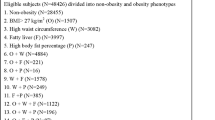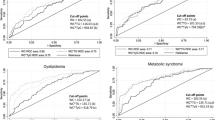Abstract
Objective:
The metabolically healthy (MHO) and unhealthy obese (MUHO) differ in terms of cardiovascular risk. However, little is known about predicting the development of these phenotypes and the future stability of the MHO phenotype. Therefore, we examined these two issues in the San Antonio Heart Study.
Design:
Longitudinal, population-based study of cardiometabolic risk factors among Mexican Americans and non-Hispanic whites in San Antonio.
Subjects:
The study sample included 2368 participants with neither MUHO nor diabetes at baseline. Median follow-up was 7.8 years. MHO was defined as obesity with ⩽1 metabolic abnormality; MUHO, as obesity with ⩾2 abnormalities.
Results:
At baseline, 1595 and 498 individuals were non-obese with ⩽1 and ⩾2 metabolic abnormalities, respectively, and 275 were MHO. Among non-obese individuals, independent predictors of incident MHO (odds ratio (OR) for 1 s.d. change (95% confidence interval)) included body mass index (8.12 (5.66–11.7)), triglycerides (0.52 (0.39–0.68)) and high-density lipoprotein cholesterol (HDL-C) (1.41 (1.11–1.81)), whereas independent predictors of incident MUHO included body mass index (5.97 (4.58–7.77)) and triglycerides (1.26 (1.05–1.51)). Among participants with ⩽1 metabolic abnormality, obesity was associated with greater odds of developing multiple metabolic abnormalities (OR 2.26 (1.74–2.95)).
Conclusions:
Triglycerides and HDL-C may be useful for predicting progression to MHO. MHO may not be a stable condition, because it confers an increased risk of developing multiple metabolic abnormalities.
This is a preview of subscription content, access via your institution
Access options
Subscribe to this journal
Receive 12 print issues and online access
$259.00 per year
only $21.58 per issue
Buy this article
- Purchase on Springer Link
- Instant access to full article PDF
Prices may be subject to local taxes which are calculated during checkout
Similar content being viewed by others
References
McLellan F . Obesity rising to alarming levels around the world. Lancet 2002; 359: 1412.
Yusuf S, Hawken S, Ounpuu S, Bautista L, Franzosi MG, Commerford P et al. Obesity and the risk of myocardial infarction in 27 000 participants from 52 countries: a case–control study. Lancet 2005; 366: 1640–1649.
Lorenzo C, Serrano-Ríos M, Martínez-Larrad MT, González-Villalpando C, González-Sánchez JL, Martínez-Calatrava MJ et al. Is waist circumference an essential component of the metabolic syndrome? Diabetes Care 2007; 30: 2141–2142.
Ruderman N, Chisholm D, Pi-Sunyer X, Schneider S . The metabolically obese, normal-weight individual revisited. Diabetes 1998; 47: 699–713.
Blüher M . Are there still healthy obese patients? Curr Opin Endocrinol Diabetes Obes 2012; 19: 341–346.
Hamer M, Stamatakis E . Metabolically healthy obesity and risk of all-cause and cardiovascular disease mortality. J Clin Endocrinol Metab 2012; 97: 2482–2488.
Hubert H, Felnlelb M, McNamara PM, Castelll WP . Obesity as an independent risk factor for cardiovascular disease: a 26-year follow-up of participants in the Framingham Heart Study. Circulation 1983; 67: 968–977.
Mokdad AH, Ford ES, Bowman BA, Dietz WH, Vinicor F, Bales VS et al. Prevalence of obesity, diabetes, and obesity-related health risk factors, 2001. JAMA 2003; 289: 76–79.
Ogorodnikova AD, Kim M, McGinn AP, Muntner P, Khan U, Wildman RP . Incident cardiovascular disease events in metabolically benign obese individuals. Obesity (Silver Spring, MD) 2012; 20: 651–659.
Kantartzis K, Machann J, Schick F, Rittig K, Machicao F, Fritsche A et al. Effects of a lifestyle intervention in metabolically benign and malign obesity. Diabetologia 2011; 54: 864–868.
Karelis AD, Messier V, Brochu M, Rabasa-Lhoret R . Metabolically healthy but obese women: effect of an energy-restricted diet. Diabetologia 2008; 51: 1752–1754.
Shin MJ, Hyun YJ, Kim OY, Kim JY, Jang Y, Lee JH . Weight loss effect on inflammation and LDL oxidation in metabolically healthy but obese (MHO) individuals: low inflammation and LDL oxidation in MHO women. Int J Obes (Lond) 2006; 30: 1529–1534.
Arsenault BJ, Cote M, Cartier A, Lemieux I, Després JP, Ross R et al. Effect of exercise training on cardiometabolic risk markers among sedentary, but metabolically healthy overweight or obese postmenopausal women with elevated blood pressure. Atherosclerosis 2009; 207: 530–503.
Muscelli E, Camastra S, Gastaldelli A, Natali A, Masoni A, Pecori N et al. Influence of duration of obesity on the insulin resistance of obese nondiabetic patients. Int J Obes Relat Metab Disord 1998; 22: 262–267.
Wildman RP, Muntner P, Reynolds K, McGinn AP, Rajpathak S, Wylie-Rosett J et al. The obese without cardiometabolic risk factor clustering and the normal weight with cardiometabolic risk factor clustering prevalence and correlates of 2 phenotypes among the US population (NHANES 1999–2004). Arch Intern Med 2008; 168: 1617–1624.
Wei M, Gaskill SP, Haffner SM, Stern MP . Waist circumference as the best predictor of noninsulin dependent diabetes mellitus (NIDDM) compared to body mass index, waist/hip ratio and other anthropometric measurements in Mexican Americans – a 7-year prospective study. Obes Res 1997; 5: 16–23.
Burke JP, Williams K, Gaskill SP, Hazuda HP, Haffner SM, Stern MP . Rapid rise in the incidence of type 2 diabetes from 1987 to 1996: results from the San Antonio Heart Study. Arch Intern Med 1999; 159: 1450–1456.
Hazuda HP, Comeaux PJ, Stern MP, Haffner SM, Eifler CW, Rosenthal M . A comparison of three indicators for identifying Mexican Americans in epidemiologic research: methodological findings from the San Antonio Heart Study. Am J Epidemiol 1986; 123: 96–112.
Matthews DR, Hosker JP, Rudenski AS, Naylor BA, Treacher DF, Turner RC . Homeostasis model assessment: insulin resistance and beta-cell function from fasting plasma glucose and insulin concentrations in man. Diabetologia 1985; 28: 412–419.
The Expert Committee on the Diagnosis and Classification of Diabetes Mellitus. Follow-up report on the diagnosis of diabetes mellitus. Diabetes Care 2003; 26: 3160–3167.
Wilson PW, D’Agostino RB, Levy D, Belanger AM, Silbershatz H, Kannel WB . Prediction of coronary heart disease using risk factor categories. Circulation 1998; 97: 1837–1847.
Phillips CM, Perry IJ . Does inflammation determine metabolic health status in obese and nonobese adults? J Clin Endocrinol Metab 2013; 98: E1610–E1619.
Meigs JB, Wilson PW, Fox CS, Vasan RS, Nathan DM, Sullivan LM et al. Body mass index, metabolic syndrome, and risk of type 2 diabetes or cardiovascular disease. J Clin Endocrinol Metab 2006; 91: 2906–2912.
Kahn SE, Prigeon RL, McCulloch DK, Boyko EJ, Bergman RN, Schwartz MW et al. Quantification of the relationship between insulin sensitivity and beta-cell function in human subjects. Evidence for a hyperbolic function. Diabetes 1993; 42: 1663–1672.
Bogardus C, Lillioja S, Mott DM, Hollenbeck C, Reaven G . Relationship between degree of obesity and in vivo insulin action in man. Am J Physiol 1985; 248: E286–E291.
Pajunen P, Kotronen A, Korpi-Hyövälti E, Keinänen-Kiukaanniemi S, Oksa H, Niskanen L et al. Metabolically healthy and unhealthy obesity phenotypes in the general population: the FIN-D2D Survey. BMC Public Health 2011; 11: 754–764.
Karelis AD, Brochu M, Rabasa-Lhoret R, Garrel D, Poehlman ET . Clinical markers for the identification of metabolically healthy but obese individuals. Diabetes Obes Metab 2004; 6: 456–457.
Guo SS, Wu W, Chumlea WC, Roche AF . Predicting overweight and obesity in adulthood from body mass index values in childhood and adolescence. Am J Clin Nutr 2002; 76: 653–658.
Williamson DF . Descriptive epidemiology of body weight and weight change in US adults. Ann Intern Med 1993; 119: 646–649.
Haffner SM, Stern MP, Hazuda HP, Pugh JA, Patterson JK, Malina R . Upper body adiposity and centralized adiposity in Mexican American and non-Hispanic whites: relationship to body mass index and other behavioral and demographic variables. Int J Obes 1986; 10: 493–502.
Haffner SM, Stern MP, Hazuda HP, Rosenthal M, Knapp JA . The role of behavioral variables and fat pattern in explaining ethnic differences in lipids and lipoproteins. Am J Epidemiol 1986; 123: 830–839.
St-Pierre AC, Cantin B, Mauriege P, Bergeron J, Dagenais GR, Despres JP et al. Insulin resistance syndrome, body mass index and the risk of ischemic heart disease. CMAJ 2005; 172: 1301–1305.
Ärnlöv J, Ingelsson E, Sundström J, Lind L . Impact of body mass index and the metabolic syndrome on the risk of cardiovascular disease and death in middle-aged men. Circulation 2010; 121: 230–236.
Soriguer F, Gutierrez-Repiso C, Rubio-Martin E, García-Fuentes E, Almaraz MC, Colomo N et al. Metabolically healthy but obese, a matter of time? Findings from the prospective Pizarra study. J Clin Endocrinol Metab 2013; 98: 2318–2325.
O’Connell J, Lynch L, Hogan A, Cawood TJ, O’Shea D . Preadipocyte factor-1 is associated with metabolic profile in severe obesity. J Clin Endocrinol Metab 2011; 96: E680–E684.
Phillips CM, Perry IJ . Does inflammation determine metabolic health status in obese and nonobese adults? J Clin Endocrinol Metab 2013; 98: E1610–E1619.
Klöting N, Fasshauer M, Dietrich A, Kovacs P, Schön MR, Kern M et al. Insulin-sensitive obesity. Am J Physiol Endocrinol Metab 2010; 299: E506–E515.
Xu XJ, Gauthier MS, Hess DT, Apovian CM, Cacicedo JM, Gokce N et al. Insulin sensitive and resistant obesity in humans: AMPK activity, oxidative stress, and depot-specific changes in gene expression in adipose tissue. J Lipid Res 2012; 53: 792–801.
Bergeron R, Previs SF, Cline GW, Perret P, Russell RR 3rd, Young LH et al. Effect of 5-aminoimidazole-4-carboxamide-1-beta-D-ribofuranoside infusion on in vivo glucose and lipid metabolism in lean and obese Zucker rats. Diabetes 2001; 50: 1076–1082.
Fisher JS, Gao J, Han DH, Holloszy JO, Nolte LA . Activation of AMP kinase enhances sensitivity of muscle glucose transport to insulin. Am J Physiol Endocrinol Metab 2002; 282: E18–E23.
Acknowledgements
This work was supported by grants from the National Heart, Lung and Blood Institute (RO1-HL24799 and RO1-HL36820).
Author Contributions
AI contributed to the analysis and interpretation of data and to write the manuscript. HPH researched data, contributed to interpretation of data and to discussion, and revised the manuscript for critically important content. SF is instrumental in the original study design, contributed to interpretation of data and to discussion, and revised the manuscript for critically important content. KA contributed to interpretation of data and to discussion, and revised the manuscript for critically important content. CL contributed to the study hypothesis and aims to analysis and interpretation of data, and to write the manuscript.
Author information
Authors and Affiliations
Corresponding author
Ethics declarations
Competing interests
The authors declare no conflict of interest.
Rights and permissions
About this article
Cite this article
Achilike, I., Hazuda, H., Fowler, S. et al. Predicting the development of the metabolically healthy obese phenotype. Int J Obes 39, 228–234 (2015). https://doi.org/10.1038/ijo.2014.113
Received:
Revised:
Accepted:
Published:
Issue Date:
DOI: https://doi.org/10.1038/ijo.2014.113
This article is cited by
-
Metabolic health and adiposity transitions and risks of type 2 diabetes and cardiovascular diseases: a systematic review and meta-analysis
Diabetology & Metabolic Syndrome (2023)
-
Association of Lifelines Diet Score (LLDS) and metabolically unhealthy overweight/obesity phenotypes in women: a cross-sectional study
BMC Women's Health (2022)
-
Association between non-alcoholic fatty liver disease and metabolically healthy deterioration across different body shape phenotypes at baseline and change patterns
Scientific Reports (2022)
-
Natural course of metabolically healthy phenotype and risk of developing Cardiometabolic diseases: a three years follow-up study
BMC Endocrine Disorders (2021)
-
Obesity and pregnancy, the perfect metabolic storm
European Journal of Clinical Nutrition (2021)



